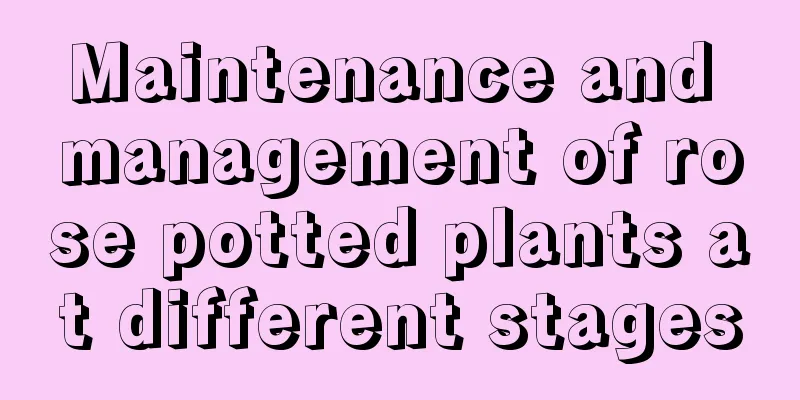Maintenance and management of rose potted plants at different stages

Rose potting managementFor seedlings grown in coarse sand or water, as well as bare-root seedlings planted in the ground, it is advisable to use plain sandy loam for planting for a period of time. After the root system grows strong, use fertilized culture soil and base fertilizer and then pot it in a larger pot for planting. Seedlings grafted with culture soil or small pots with soil clumps for ground planting can be planted in ordinary culture soil. When planting in pots, first soak the new pots with water, wash the old pots clean, and place a 1 cm to 3 cm thick coarse sand at the bottom of the pots as a drainage layer depending on the size of the pots. Then fill in some soil according to the size of the tree. For bare-root plants, make a small hill in the center of the pot. Use your left hand to straighten the plant and fill in the soil with your right hand. As you fill in the soil, gently lift the seedling upward so that the roots hang down at 45 degrees. After planting, compact the soil. If the roots are potted with soil, straighten the roots and plant them straight. There is generally no limit on the time for potting seedlings. Once they are grown and survived, they should be potted in time to prevent them from growing too tall and becoming weak. Large trees planted in the ground must be potted during the dormant period after the leaves fall in winter or before sprouting in early spring. Otherwise, its normal growth and development will be affected, the tree will weaken, and it will take a long time to recover. When potting, the soil should be moist and loose. Do not water it thoroughly after potting. Pay attention to shade and shelter from wind. This will not only promote rapid healing of broken roots, but also facilitate recovery and vigorous growth. Rose pot managementAccording to the growth trend and development needs of the plant, the rose is removed from the small pot and planted in a large pot, including the transition from planting in plain soil to planting in culture soil. There is generally no limit on the time for repotting. For example, if the seedlings planted in No. 2 pot in spring are growing vigorously, they can be repotted into No. 9 pot between July and August. If the plant is larger, it can be planted in a larger pot. When removing the plant from the pot, use the index and middle fingers of your right hand to pinch the stem of the plant, keep your palm close to the soil surface, and hold the bottom of the pot with your left hand to turn it over. For small seedlings, gently hit the edge of the pot with your hands. For large pots, hold the pot with both hands and tap the edge of the pot on a hard surface to remove the whole clump from the plant. The original potting soil should be well watered in advance. It should not be too dry or too wet when removed from the pot. Use culture soil to plant in the inverted pot. First remove the entire topsoil (Baogaier) and the lower drainage layer, then slightly spread out and straighten the fibrous roots coiled around the root ball. Be gentle and do not let the ball loose. Then place it in the pot, add 20 to 60 grams of hoof slices as base fertilizer, fill the soil into a mound, and then invert the pot and continue normal maintenance. Rose repotting managementTo maintain vigorous growth and symmetrical posture of various types of roses that have developed into potted plants for two years, it is necessary to combine pruning after leaf fall and before germination, replace the potting soil and apply base fertilizer every year. When repotting, generally use pots of the original specifications and do not increase the size. Seal and store them in soil cellars during the winter. After the whole clump is removed from the pot, the roots should be dug out. First, remove the surface cover and the bottom drainage layer of the root clump, and then cut off the densely coiled fibrous roots around the root clump. Pay attention to check and remove rotten roots and nodules, and keep the root protection soil without loose clumps. The total amount of old potting soil removed should not exceed 1/2. Then put it into a cold cellar for transplanting, and use new soil for potting in the next spring. If placed in a cold room or a film sunbed in winter, you can replace the soil with new one and plant it in the original pot. The operation points are the same as for repotting. After repotting, water thoroughly once and then place in a cold room or sunny bed for maintenance. Water and fertilizer management of rosesPotted roses should be watered in time during the growing period and the soil in the pot should be kept moist at all times. In hot and dry seasons, it is advisable to spray water on the leaves and the surrounding environment to keep the branches fresh. In cold seasons, it is advisable to spray water on the leaves and the surrounding environment to keep the branches fresh. In cold seasons, control water, but the soil in the pot should not dry out. Fertilization should be based on the fertilizer preferences of different varieties and the needs of each stage of growth and development, as well as the temperature, light and growth strength, and base fertilizer or topdressing should be applied in a timely and appropriate manner. |
<<: How to plant feather-leaf iris
>>: Cultivation method of iron tree
Recommend
Cultivation methods and precautions of multi-leaf aloe
1. Breeding methods 1. Soil In most cases, it lik...
Clematis planting and maintenance
1. Planting method 1. Prepare the potting soil: W...
The flowers that were about to die in the summer were thrown away by others, but she picked them up and grew them to the point where the pots were full in just one month!
Saving Yellowing and Wilting Gardenias Gardenia i...
Cultivation methods and precautions of Quisqualis
How to cultivate Quisqualis Light and temperature...
How to fertilize avocado
Avocado fertilization technology Generally speaki...
Key points and steps of Xianglian planting technology
Xianglian is not only a famous specialty of Hunan...
How to prune plum blossoms
1. Processing the terminal buds After growing for...
Where are the best places to grow blackcurrants?
Blackcurrant growing conditions Black currant pre...
High-yield rice planting technology
As one of the important food crops, rice has a ve...
How to cut off Ji Longyue's head
time Strictly speaking, there is no specific time...
How to grow trumpet creeper and how to climb vines
1. How to grow trumpet creeper 1. Light: Trumpet ...
Things to note when repotting Clivia
1. Time to change pots If you feel that the Clivi...
What is the method of growing Bermuda grass?
1. Temperature Bermuda grass has poor cold resist...
How to deal with hydrangea after it blooms
Treatment after hydrangea blooms 1. Pruning time ...
Is Datura poisonous?
1. Highly toxic It can be said that the entire bo...









